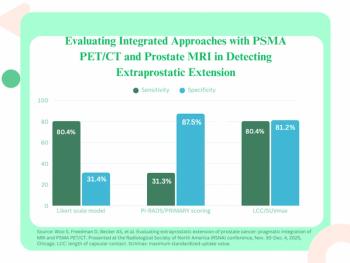For patients with locally advanced breast cancer, positron emission tomography/computed tomography (PET/CT) may provide enhanced detection of oligometastatic and polymetastatic disease.
In a post-hoc analysis from a prospective multicenter trial, recently published in Radiology, researchers compared fluorodeoxyglucose (FDG) PET/CT to CT and bone scintigraphy (CTBS) in 369 women (mean age of 53) with locally advanced breast cancer.
The study authors found a higher percentage of oligometastatic disease (OMD) detection with FDG PET/CT (11 percent) in comparison to CTBS (4 percent). There was also increased detection of polymetastatic disease (defined as > five distant metastases) with FDG PET/CT (13 percent) in contrast to CTBS (7 percent), according to the researchers.
“These results suggest that if radical therapy with a potential long-term disease-free duration is planned for OMD, staging with CTBS alone is insufficient,” wrote lead study author Ur Metser, M.D., the division head of molecular imaging at the Joint Department of Medical Imaging for University Medical Imaging Toronto and the Women’s College Hospital Cancer Center in Toronto, and colleagues.
For women with OMD and axillary lymph node metastases, the researchers noted that extra-axillary regional lymphadenopathy was detected with FDG PET/CT in 32 percent of patients in contrast to 13 percent with CTBS. While noting a lack of statistical significance with this finding, the study authors said this is a key consideration in the management of these patients.
Three Key Takeaways
- Improved detection of metastatic disease. FDG PET/CT identified higher rates of oligometastatic (11 percent vs. 4 percent) and polymetastatic disease (13 percent vs. 7 percent) compared to CT and bone scintigraphy (CTBS) in locally advanced breast cancer.
- Impact on regional disease assessment. In women with OMD and axillary lymph node involvement, PET/CT detected more extra-axillary lymphadenopathy (32 percent vs. 13 percent) and extra-regional lymph node metastases (16 percent vs. 0 percent), potentially altering surgical and radiation planning.
- Greater detection of liver metastases. PET/CT demonstrated superior detection of liver metastases (32 percent vs. 13 percent) compared to CTBS, which may influence systemic therapy decisions.
“This discrepancy in performance may influence treatment plans such as the extent of surgery or the radiation fields used to optimize local disease control,” added Metser and colleagues.
The researchers also noted that FDG PET/CT detected higher percentages of extra-regional lymph node metastases (16 percent vs 0 percent) and liver metastases (32 percent vs. 13 percent) in comparison to CTBS in patients with OMD.
(Editor’s note: For related content, see “PET/CT Shows Superior Results for Detecting Oligometastatic Breast Cancer in Comparison to CT,” “Researchers Show Higher Breast Cancer Upstaging Rate with 18F-FAPI PET/CT” and “Can Radioligand Therapy Have an Impact for Women with Breast Cancer?”)
In regard to study limitations, the authors noted the exploratory nature of the research and acknowledged more robust data collection for the 18F-FDG PET/CT arm of the study in comparison to the CTBS cohort. The researchers also conceded a lack of data on long-term survival.




























